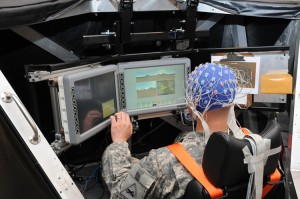BCI: Mind over Movement
Thursday, July 27th, 2017July 27, 2017
In the 1940’s, people connected wires, punched cards, and flipped switches to give instructions to early computers. Over time, the command line interface (CLI) was developed, allowing users to instruct a computer simply by typing text commands. By the mid-1980’s, CLI was replaced by the graphical user interface (GUI), a visually intuitive interface that is still in popular use today. Through GUI, users interact with windows and icons to command a computer. People around the world use GUI by pressing keys, clicking on computer mice, speaking words, and swiping screens.
Today, a new interface looms on the horizon: brain-computer interface (BCI) (sometimes called brain-machine interface, or BMI). BCI technology creates a pathway from the user’s brain to a computer or other device, allowing direct thought communication. Brainwaves are recorded through electrodes (strips of metal that conduct electricity) attached to a person’s scalp or implanted in the brain. BCI technology has been in development since the end of the 1960′s, when the idea of using only one’s mind to control a device was barely more than fantasy. Progress was slow, but today that fantasy is at last becoming reality.
BCI allows users to command devices without using their hands or voices. Some people who suffer from paralysis or other immobility-inducing conditions have already benefited from BCI technology. These individuals have gained the ability to move and control external devices using only their minds, which allows them a greater degree of independence. In February 2017, physiatrists (physical medicine and rehabilitation physicians) from the Hunter Holmes McGuire VA Medical Center in Richmond, Virginia, announced the development of a BCI device for controlling movement in a prosthetic knee. A simple prosthetic knee normally requires manual unlocking to bend, but this device allows the patient to bend the prosthesis using only the mind.
In March 2017, a team of biomedical researchers in Cleveland, Ohio, successfully restored limited arm movement to a quadriplegic man by implanting tiny electrodes directly onto his motor cortex, a region of the brain that controls muscle movement. These electrodes connected to a device affixed to the man’s arm. After some training and practice, he was able to move his shoulder, elbow, wrist, and fingers. BCI technology is also being developed to allow individuals with locked-in syndrome to communicate with the outside world. Locked-in syndrome is characterized by the complete paralysis of voluntary muscles, except in some cases for the muscles that control eye movement.
Medical BCI milestones caught the attention of people in California’s Silicon Valley, and leading technology companies are exploring BCI’s potential for commercial use. In April, Facebook executives announced a project to create a wearable BCI device that would allow the wearer to compose words directly from the brain. CEO Mark Zuckerberg expects BCI “typing” to be up to five times faster than manual finger typing.
In March 2017, South Africa-born entrepreneur Elon Musk announced the establishment of Neuralink, a new BCI development company. The initial goal of Neuralink is to improve the lives of immobile and brain-damaged patients through the development of brain implants. Musk added, however, that the ultimate goal of the company is for BCI to improve human cognition—a goal meant to keep humanity from becoming obsolete in the face of ever-advancing artificial intelligence.
A related start-up company called Kernel (founded by U.S. entrepreneur Bryan Johnson) aims to create cutting-edge BCI devices. Kernel is currently focused on improving knowledge of the human brain in hopes of augmenting it in the coming decades. Kernel and Neuralink have the same end goal: to allow humanity to compete with advanced machines by merging biological and digital intelligence and application.
Some people question the necessity of advanced BCI technology, and others dismiss such neural ambitions as science fiction. But many people predict that—in the not-too-distant future—artificial intelligence will surpass that of humans, much as human intelligence surpassed that of other animals. Musk envisions a future in which people use BCI technology to connect quickly to databases, servers, and even to one another, somewhat leveling the competition with artificial super-intelligence.
Neuroscientists disagree on how soon people can expect to be able to type directly from their brains or use telepathic devices to communicate with one another. Many do agree, however, that it is no longer a matter of if, but when humanity’s next evolutionary stage will come to fruition. Years in the future, we may look back at 2017 as a turning point in the evolution of brain-computer interface.




